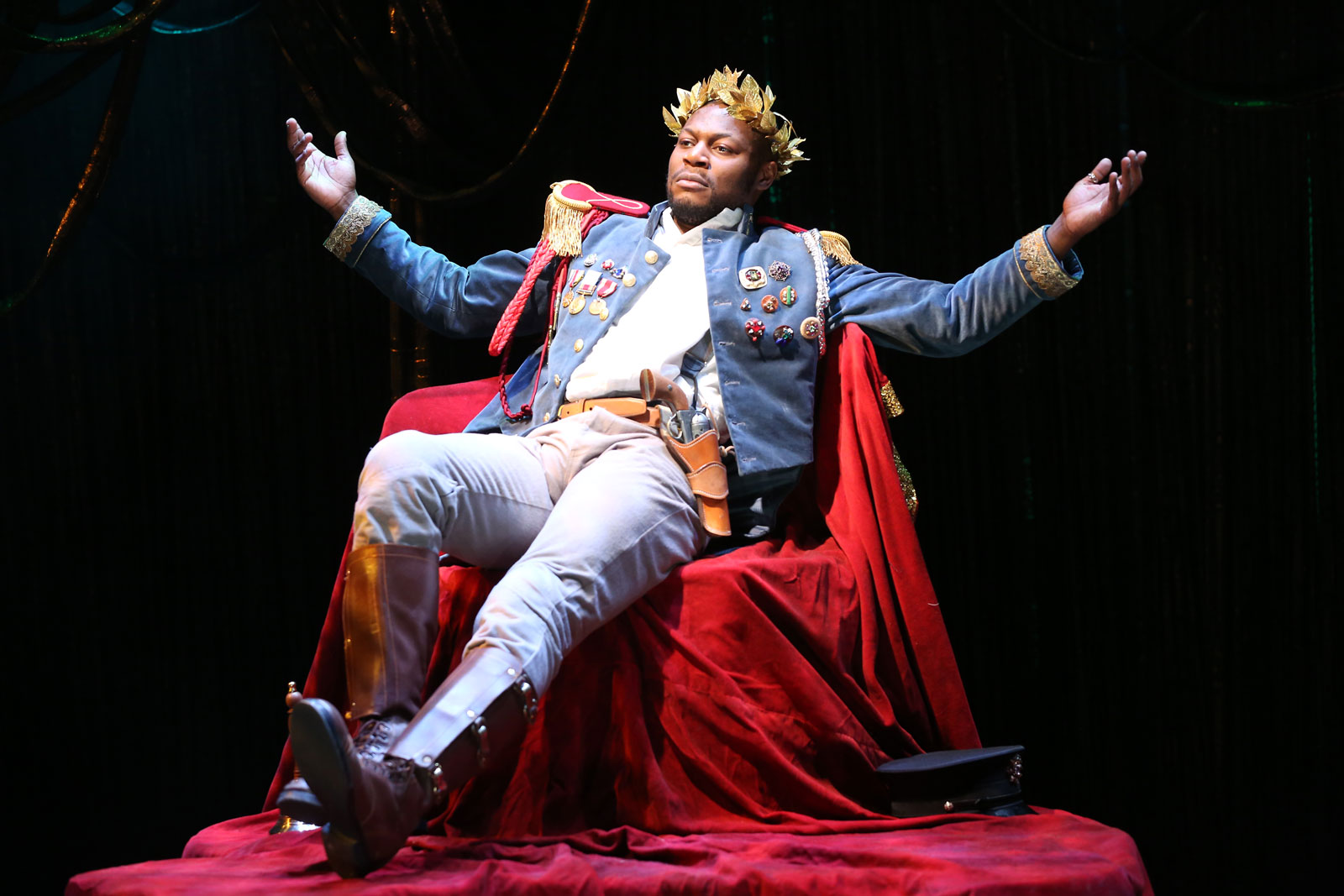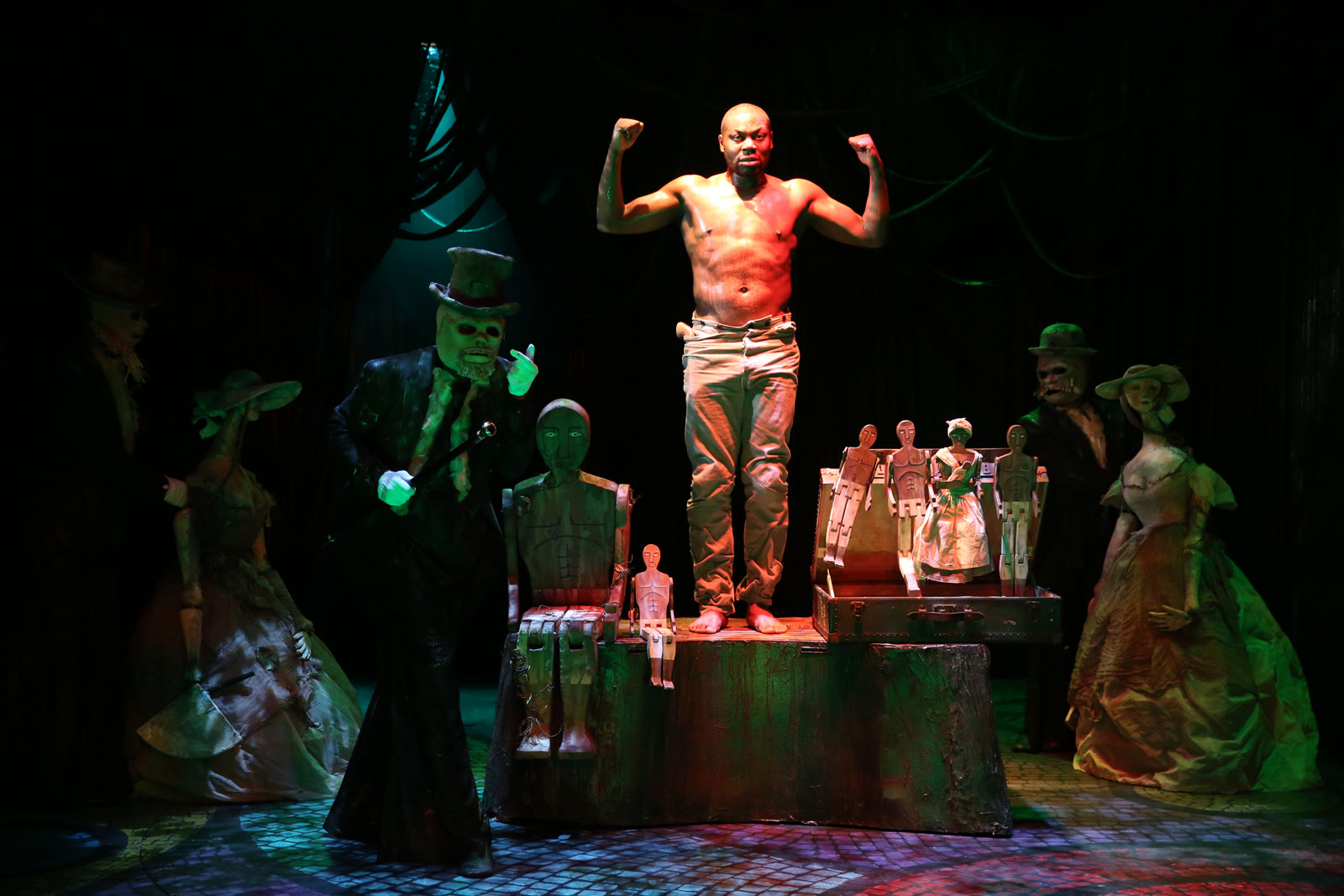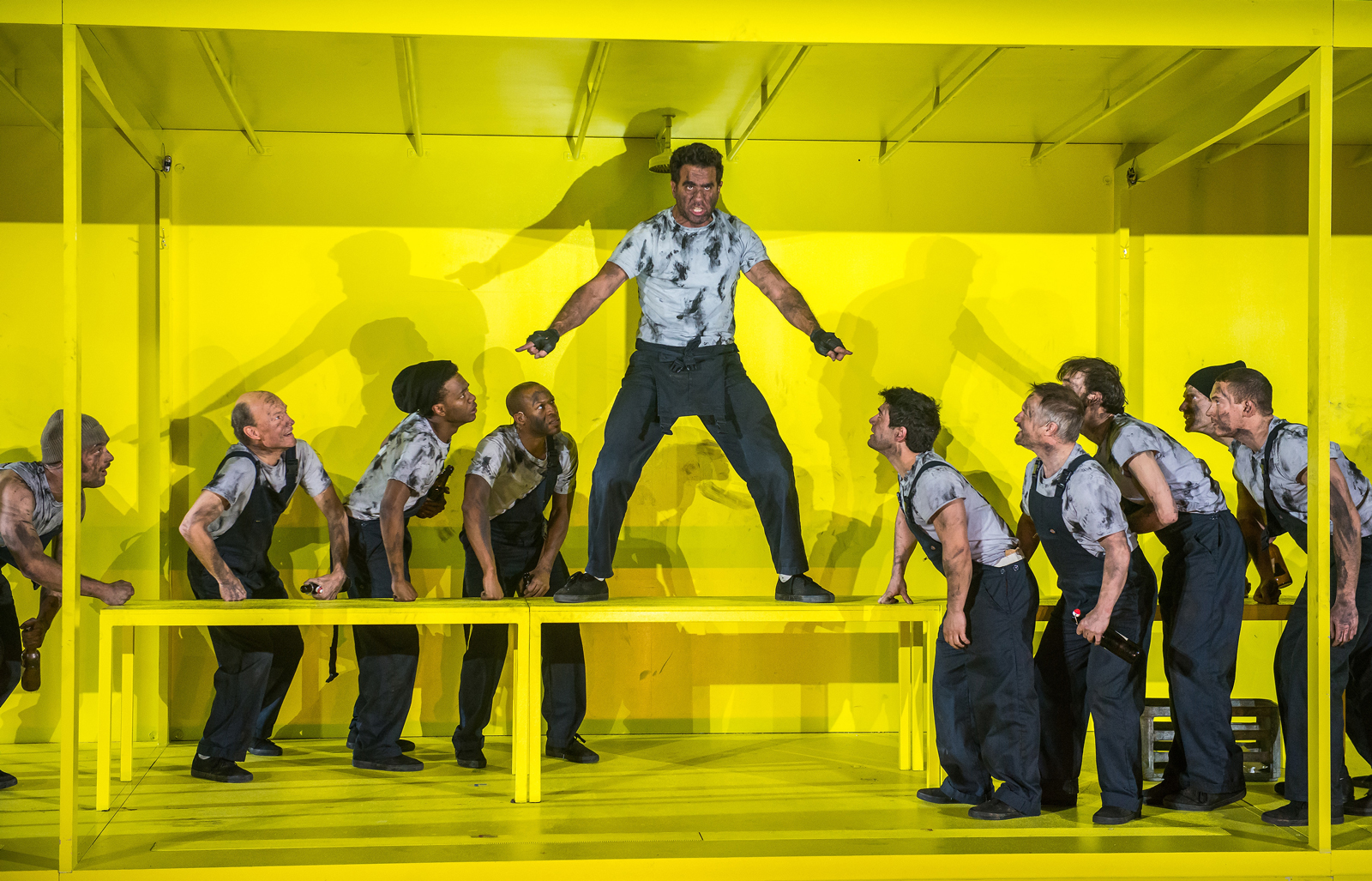Eugene O’Neill wrote The Emperor Jones and The Hairy Ape within a year of each other; one might almost say back to back, except that he wrote three other plays in between and oversaw productions of three more (including the Pulitzer Prize-winning Anna Christie). As it happens, both works are currently being performed in New York, in vigorous productions that demonstrate how much disruptive energy these two familiar, and in many ways complementary, plays are still capable of stirring up.
The early 1920s were a busy time for O’Neill, as he made the transition from the avant-garde precincts of the Provincetown Players to Broadway acclaim, while the chaos of his family history continued to rain down on him. The night The Hairy Ape opened in March 1922, the body of his mother was arriving by train at Grand Central, in the care of his older brother Jamie, who was in the alcoholic throes of a full-blown bender. O’Neill neither attended the opening nor met the train, spending the evening alone in a hotel room instead.
Emperor Jones and Hairy Ape are not autobiographical plays—he would get to that later—but they are pure and altogether personal distillations of the destructive and disorderly forces that hovered around O’Neill’s life early and late. They mirror each other. Each is to be performed in eight scenes without interruption. Each is centered on a lone protagonist of socially humble origins (a Pullman porter in The Emperor Jones, a stoker on an ocean liner in The Hairy Ape) who asserts his will to power, one making himself emperor of a Caribbean island, the other persuading himself that as he feeds the ship’s furnace he embodies the force that makes the whole world go. Each sends its protagonist through a series of punishing episodes toward a goal that he cannot possibly attain.
Both plays have the schematic structure of predetermined ceremonies. This ceremonial aspect defines the theatrical language that O’Neill forged here, an inherently uneasy fusion of precise behavioral observation and stylized ritual that can never quite settle down but that continues to offer enormous openings for actors and directors and stage designers. The radicalism of these plays and the impact of their original productions is an old story, suffused with echoes of Nietzsche and Stirner and Wedekind, informed by once-novel enthusiasms for Noh drama and African masks and The Cabinet of Dr. Caligari. Yet despite the accretion of what are by now commonplaces and stereotypes, an unresolved urgency remains that permits the plays to be made new. Scrape away the familiarity and it becomes strange again. When the stoker Yank, nearing the end of his hurtling progression, cries out “Where do I fit in?” it’s still possible to feel the jolt of a moment when the phrase was still fresh, even abrasive.
The current New York stagings of the two plays could not be more different in scale. Ciarán O’Reilly’s Emperor Jones at the Irish Repertory Theatre unfolds in a small space whose tiny dimensions encourage the most intimate possible theatrical experience, while The Hairy Ape, directed by Richard Jones, makes full use of the cavernous reaches of the Park Avenue Armory’s Drill Hall, so that the play’s protest against modern technology becomes at moments a demonstration of the power and terror of that technology. Both productions benefit from actors—Obi Abili as Brutus Jones and Bobby Cannavale as Yank—with the necessary force for roles that are not merely the centers but the engines of these plays. All other characters do no more than goad and inflect the solitary self as it barges through O’Neill’s funhouse of ghosts and guards and choral commentators.
Of the two plays, The Emperor Jones poses more difficulty for contemporary audiences, with its pulpish exoticism (silver bullets, jungle witch doctors, the beating of native drums), the Emperor’s painstakingly notated dialect (“Dey’s some tings I ain’t got to be tole”), the apparent reduction of African-American life to a few well-worn images (church service, crap game, chain gang). Jones’s flight through the forest after he learns that the subjects he has exploited have determined to put an end to him—his gathering terror as he loses his way and is haunted by his own past crimes—summons up buried strata of melodramatic association. When as a child I came upon the play in an anthology of great one-act plays, what carried me along was its resemblance to a horror comic in which witch doctors and silver bullets would not have been out of place. But the horrors evoked are real enough in the end, with scenes of a slave auction and the Middle Passage called up on stage for a New York audience that in 1920 was not often exposed to such images.
Advertisement
When read on the page, O’Neill’s plays often seem to create an impression of confusion or difficulty—of false starts, unneeded repetitions, incomprehensible circling around and back. But this impression evaporates in a good stage performance. The characters exist even if their words are disordered or self-contradictory, or if they skate back and forth over a banal surface. They know more than they are able to say. As played by Abili, Brutus Jones is mistrustful, reluctant to examine his own motives too closely, amused by the superiority of his own intelligence and happy to congratulate himself for any victory large or small; he is at the same time aware of his own games and contemptuous of a world that forces him to play them. The fear that overwhelms him does not come from within but is forced on him by everything that he cannot control, everything that finally grinds him down toward the fate he has spent the whole play working to avoid, of becoming a sacrificial victim.
Abili’s Emperor Jones easily commands the Irish Rep’s tiny stage—a space so small, for a play about flight, that it almost seems there is nowhere for him to run. The forest here is made up of costumed actors, and the play’s geography is defined by the balletic interweavings of the fugitive and the animate foliage that trips him, blocks him, and closes in on him. The Emperor Jones becomes a play for dancers, with language restricted for the most part to the emperor’s sustained vernacular aria. Masks and large puppets surge up from the shadows as each episode reaches its moment of crisis. O’Neill praised the original production for its “new system of staging of extreme simplicity and flexibility” permitting “a combination of the scope of the movies with all that is best of the spoken drama.” O’Reilly and the Irish Rep achieve a comparable flexibility, with effects no less persuasive for the transparency of their artifice. In the stage’s narrow confines, the impression is of a single, thoroughly real man forcing his way through a world visibly unreal, watching as layer after layer peels away.
For The Hairy Ape, Richard Jones (who directed the play previously in London at the Old Vic) has entirely different resources to work with, and has brought an element of circus-like surprise, and circus-like visual scope, to the proceedings. The audience is seated in the center of the hall, in a semicircle of bright yellow steeply banked seats, while a steamy mist obscures the surroundings. Sudden darkness and booming industrial noise deliver an abrupt disturbing shock; a ring of lights up above manufactures the illusion that we are somewhere very deep down in an immense structure. The temblor of this spatial disorientation is momentary but visceral, and without a moment’s delay we are off into the action of the play, which will roll out, literally, on a revolving platform that encircles the audience and from which actors will at various times disembark to clamber up the aisles or to set out into the flat dark plain lying beyond the platform. Further depths and distances are conjured by high beams of light and the voices of unseen bystanders. The manipulations are subtle and constantly shifting, and manage by turns to suggest tight close-ups and receding panoramas—very much, evidently, in the spirit of the original 1922 production by the Provincetown Players (praised by Alexander Woollcott for its “illusion of vast spaces and endless perspectives”) but undoubtedly benefiting from a level of technology that the Players could scarcely have imagined.
The Hairy Ape was one of O’Neill’s favorites among his plays, perhaps because it seems to follow such a pure line of associative logic, moving with dreamlike certainty from ocean liner to Fifth Avenue to a prison cell and finally to a cage in the zoo. The elements that come into play are numerous and varied but again there is really only one character, the stoker Yank. His unwavering identification with the power and forward movement of the ship in whose bowels he works, expressed in a stream of undiluted Brooklynese—“I’m de end! I’m de start! I start somep’n and de woild moves!”—is fatally disturbed by the brief intrusion in the stokehole of a slumming heiress who takes one look at him and calls him a “filthy beast.” The heiress, the ghostly pale daughter of the world’s greatest steel magnate, never appears again, but she lingers as an inescapable verbal presence in Yank’s rants as he tries to imagine some appropriate revenge for her contempt. The movement of the revolving platform makes an appropriate figure for the play’s essential story. Yank is thrown off balance and can never get his footing back. With every lurch, as he struggles to understand what has happened to him, he flails in rage against something that he can intuit but never precisely define. Almost at the last gasp he has to acknowledge: “Tinkin’ is hard—”
Advertisement
O’Neill had the mysterious gift of deriving varied and subtle dramatic effects from what might seem like blunt-force characterizations. Yank must be one of the most wearing roles for an actor, since he starts on a note of aggressive self-assertion and then slides successively in and out of rage, depression, confusion, bitter resignation, and desperate combativeness without ever a moment of respite or tranquil understanding. Through all those mood swings he retains an unmodulated obtuseness only lightly touched by glimmers of light that stay just out of his reach. It is like a protracted portrait of a man beating his head against a wall, surrounded by a crowd of others (stokers, bourgeois strollers, policemen, prisoners, radical intellectuals) who never figure as more than momentary figures in his dream. In true O’Neill fashion he becomes fixated on a single word—“belong”—reconfiguring it over and over: “We belong and dey don’t.” “Dat belongs.” “Yuh don’t belong, get me!”
Bobby Cannavale brings a sense of athletic exuberance to the first drunken scene among the stokers, as he jumps on tables and hoists himself on pipes and relishes his top dog status among his fellows. His brightness matches the blinding bright yellow of the stokers’ cage, and his leaps have an almost musical comedy élan, which fits in with the elaborate freeze-frame choreography of the sequence, the stokers immobilized at odd angles every time the ship shifts from side to side. O’Neill did in fact describe the play as a comedy, even if the laughs are hollow indeed. The funniest scene, in which Yank attempts the join the Wobblies and ends by getting beaten up as a suspected police provocateur, epitomizes its air of brutal vaudeville.
The turning of the stage at the Armory generates a constant childlike curiosity about what will emerge next, right up to the moment when things come to a dead halt with Yank’s encounter with the genuine hairy ape. It is to the credit of the production that there wasn’t a hint of deflating laughter at this delicate juncture. The sheer strangeness of the scene, like something retrieved from a dream, is a confirmation of The Hairy Ape’s inexorable feeling of occult navigation. Another necessary ritual of sacrifice has been fulfilled, no less harrowing for all the absurdity of the circumstances.
Eugene O’Neill’s The Emperor Jones is at the Irish Repertory Theatre through May 21. O’Neill’s The Hairy Ape is at the Park Avenue Armory through April 22.




